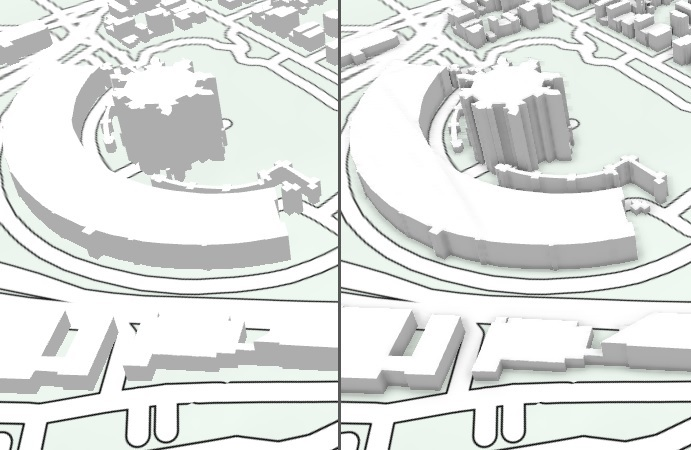AmbientOcclusionEffect Class
An effect that applies ambient occlusion to the result produced by a layer or a view.
NuGet/Assembly: Carmenta.Engine.5.17.0.nupkg (in the CECore assembly)
Syntax
public class AmbientOcclusionEffect : EffectRemarks
There is a map configuration sample effects_ambient_occlusion.px that shows how to use the AmbientOcclusionEffect to improve the lightning in a GlobeView.
 |
Ambient occlusion for a point in the world is a measure of how accessible it is to light. This value is computed for every pixel on the screen and will darken pixels depending on their light accessibility. This is only an approximation and uses color and depth information about the rendered scene as input, and can generate artifacts along and outside some edges.
The light accessibility for each pixel is computed by sampling for occlusion in a hemisphere that is aligned with the surface normal. The samples within this hemisphere are distributed so that they get more dense closer to the position we want the result for. The radius of the hemisphere used by the calculation is controlled with the property Radius and is measured in meters.
The AmbientOcclusionEffect uses the depth buffer of the previously rendered content to compute the occlusion. If this effect is placed on a layer, then this depth buffer will not only contain information about the depth of rendered objects under the layer but also of previously rendered objects as the depth buffers primarily purpose is to make sure that only the visible fragments will be shown to the screen. This will make the effect behave slightly different from other effects as it access information about other previously rendered layers as well. Luckily this makes sense as the visualization of the ambient occlusion effect on a partial depth buffer would create a very irregular visual result due to areas with missing depth. These irregularities would not be distinguishable from real geometry with the same shape and would lead to occlusions between areas with content and areas without content. Simply put; using an AmbientOcclusionEffect will apply the effect with the knowledge of the depth of the fragments of all previously rendered layers. Thus it is recommended to use the AmbientOcclusionEffect on the last layer that the effect should be applied on, before visualization such as texts or other GUI elements.
Performance
The AmbientOcclusionEffect is computationally heavy. Graphics hardware integrated on the CPU in many laptops are usually not sufficient for good performance and a dedicated graphics adapter is recommended.
Inheritance Hierarchy
System.Object
EngineObject
ResourceObject
Effect
AmbientOcclusionEffect
Platforms
Windows, Linux, Android
AmbientOcclusionEffect Members
The AmbientOcclusionEffect type has the following members.
Constructors
| Name | Description |
|---|---|
| AmbientOcclusionEffect | Initializes a new instance of the AmbientOcclusionEffect. |
Properties
| Name | Description |
|---|---|
| IsDisposed | Gets a value that tells whether the current AmbientOcclusionEffect has been disposed. Inherited from EngineObject |
| MaxDistance | Gets or sets the maximum distance between a position in the world and the camera for which the effect is applied. |
| Name | Gets or sets the name of the AmbientOcclusionEffect. Inherited from ResourceObject |
| NativeHandle | Gets the native Carmenta Engine kernel object the current AmbientOcclusionEffect represents. Inherited from EngineObject |
| Radius | Gets or sets the radius of the hemisphere that is searched for occluding geometry. |
| Strength | Gets or sets the strength of the effect. Inherited from Effect |
| IUserProperties.UserProperties | Gets the AttributeSet that contains the user properties. Inherited from IUserProperties |
Methods
| Name | Description |
|---|---|
| Clone | Creates a copy of an object. Inherited from EngineObject |
| Dispose | Releases the reference to the native Carmenta Engine kernel instance the EngineObject represents. Inherited from EngineObject |
| Equals | Determines whether this instance is equal to another. Inherited from EngineObject |